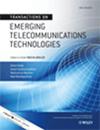V. Venkatkumar, T. Haustein, M. Faulkner
{"title":"中继结果为室内覆盖在长期演变和超越","authors":"V. Venkatkumar, T. Haustein, M. Faulkner","doi":"10.1002/ett.1450","DOIUrl":null,"url":null,"abstract":"Future cellular networks aim to improve the data rate to users in office and residential buildings. Wireless relaying is one of the possible solutions. In this approach, a relay is placed inside a building to get around the building penetration path loss. Decode and forward operation is employed for full re-use of the licensed bandwidth with frequency dependent link adaptation. In this paper, we report indoor measurement results using state of the art macrocellular and relay. Orthogonal frequency division duplexing (OFDM) and multiple input multiple output (MIMO) are used in both links. The relay measurements were performed for a single cell three terminal relay network setup. Results show that (a) relay provides better data rate and coverage as compared to macro and (b) feedback can further improve relay coverage. A relay is able to deliver data rate exceeding 40 Mbps to locations well inside the building. Copyright © 2010 John Wiley & Sons, Ltd.","PeriodicalId":50473,"journal":{"name":"European Transactions on Telecommunications","volume":"11 1","pages":"770-779"},"PeriodicalIF":0.0000,"publicationDate":"2010-12-01","publicationTypes":"Journal Article","fieldsOfStudy":null,"isOpenAccess":false,"openAccessPdf":"","citationCount":"8","resultStr":"{\"title\":\"Relaying results for indoor coverage in long-term evolution and beyond\",\"authors\":\"V. Venkatkumar, T. Haustein, M. Faulkner\",\"doi\":\"10.1002/ett.1450\",\"DOIUrl\":null,\"url\":null,\"abstract\":\"Future cellular networks aim to improve the data rate to users in office and residential buildings. Wireless relaying is one of the possible solutions. In this approach, a relay is placed inside a building to get around the building penetration path loss. Decode and forward operation is employed for full re-use of the licensed bandwidth with frequency dependent link adaptation. In this paper, we report indoor measurement results using state of the art macrocellular and relay. Orthogonal frequency division duplexing (OFDM) and multiple input multiple output (MIMO) are used in both links. The relay measurements were performed for a single cell three terminal relay network setup. Results show that (a) relay provides better data rate and coverage as compared to macro and (b) feedback can further improve relay coverage. A relay is able to deliver data rate exceeding 40 Mbps to locations well inside the building. Copyright © 2010 John Wiley & Sons, Ltd.\",\"PeriodicalId\":50473,\"journal\":{\"name\":\"European Transactions on Telecommunications\",\"volume\":\"11 1\",\"pages\":\"770-779\"},\"PeriodicalIF\":0.0000,\"publicationDate\":\"2010-12-01\",\"publicationTypes\":\"Journal Article\",\"fieldsOfStudy\":null,\"isOpenAccess\":false,\"openAccessPdf\":\"\",\"citationCount\":\"8\",\"resultStr\":null,\"platform\":\"Semanticscholar\",\"paperid\":null,\"PeriodicalName\":\"European Transactions on Telecommunications\",\"FirstCategoryId\":\"1085\",\"ListUrlMain\":\"https://doi.org/10.1002/ett.1450\",\"RegionNum\":0,\"RegionCategory\":null,\"ArticlePicture\":[],\"TitleCN\":null,\"AbstractTextCN\":null,\"PMCID\":null,\"EPubDate\":\"\",\"PubModel\":\"\",\"JCR\":\"\",\"JCRName\":\"\",\"Score\":null,\"Total\":0}","platform":"Semanticscholar","paperid":null,"PeriodicalName":"European Transactions on Telecommunications","FirstCategoryId":"1085","ListUrlMain":"https://doi.org/10.1002/ett.1450","RegionNum":0,"RegionCategory":null,"ArticlePicture":[],"TitleCN":null,"AbstractTextCN":null,"PMCID":null,"EPubDate":"","PubModel":"","JCR":"","JCRName":"","Score":null,"Total":0}
引用次数: 8

 求助内容:
求助内容: 应助结果提醒方式:
应助结果提醒方式:


